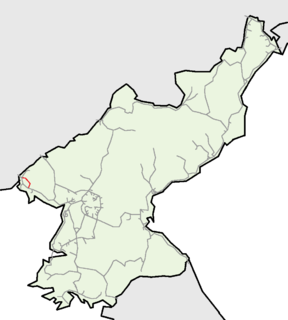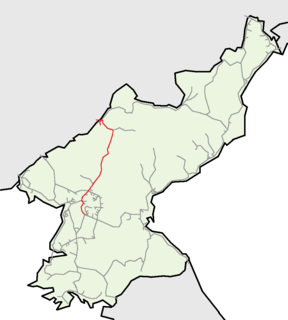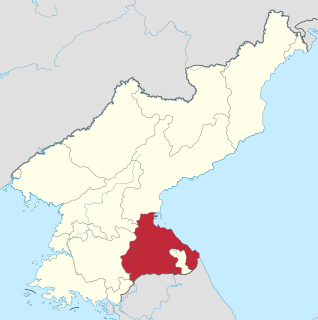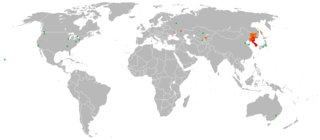
Munch'ŏn is a North Korean city located in Kangwŏn Province. It lies on the coast of the Sea of Japan and borders Wonsan.

The Kaech'ŏn Line is an electrified standard-gauge secondary line of the Korean State Railway running from Sinanju on the P'yŏngŭi Line to Kaech'ŏn on the Manp'o Line.

The Paengma Line is a non-electrified standard-gauge secondary line of the Korean State Railway in North P'yŏngan Province, North Korea, running from Yŏmju on the P'yŏngŭi Line to South Sinŭiju, likewise on the P'yŏngui Line.

The Tasado Line is a non-electrified standard-gauge secondary line of the Korean State Railway in North P'yǒngan Province, North Korea, running from Ryongch'ŏn on the P'yŏngŭi Line to Tasado Port.

The Hwanghae Ch'ŏngnyŏn Line is an electrified standard-gauge secondary line of the Korean State Railway in the North and South Hwanghae provinces of North Korea, running from Sariwŏn to Haeju. It connects to the P'yŏngbu Line at Sariwŏn, to the Ŭnnyul Line at Ŭnp'a, to the Paech'ŏn Line at Changbang, and to the Ongjin Line at Haeju. It plays an important role in the transportation of freight and passengers in North and South Hwanghae provinces, serving important mining and industrial areas, as well as one of the DPRK's most important ports for foreign trade.

The Ŭnnyul Line is a non-electrified standard-gauge secondary line of the Korean State Railway in the North and South Hwanghae provinces of North Korea, running from Ŭnp'a to Ch'ŏlgwang. It is an important line in economic terms, connecting the agricultural and ore-producing areas of Kwail and Ŭnnyul counties with the rest of the DPRK.

The Paech'ŏn Line is a partially electrified standard-gauge secondary railway line of the Korean State Railway in South Hwanghae Province, North Korea, running from Changbang on the Hwanghae Ch'ŏngnyŏn Line to Ŭnbit.

The P'yŏngdŏk Line is an electrified standard-gauge trunk line of the Korean State Railway in North Korea running from Taedonggang Station in P'yŏngyang, where it connects to the P'yŏngbu, P'yŏngnam, P'yŏngra and P'yŏngŭi Lines, to Kujang, where it connects to the Manp'o and Ch'ŏngnyŏn P'arwŏn Lines. The total length of the line is 192.3 km (119.5 mi).

The Changjin Line is an electrified narrow gauge line of the North Korean State Railway running from Yŏnggwang on the Sinhŭng Line to Sasu on Lake Changjin. There is a 7.4 km cable-hauled section between Samgo and Hwangch'oryong; between Pojang and Hwangch'oryong the grade reaches 370‰.

The Manp'o Line is an electrified standard-gauge trunk line of the North Korean State Railway running from Sunch'ŏn on the P'yŏngra Line to Manp'o on the Pukpu Line. The line continues on from Manp'o to Ji'an, China.

The Paektusan Ch'ŏngnyŏn Line is an electrified standard-gauge secondary mainline of the Korean State Railway running from Kilju on the P'yŏngra Line to Hyesan on the Pukpu Line; it connects to the narrow gauge Paengmu Line at Paeg'am Ch'ŏngnyŏn Station, and to the Samjiyŏn Line at Wiyŏn Station.

The Hambuk Line is an electrified standard-gauge trunk line of the Korean State Railway in North Korea, running from Ch'ŏngjin) on the P'yŏngra Line to Rajin, likewise on the P'yŏngra line.

The Kangwŏn Line is a 145.8 km (90.6 mi) electrified standard-gauge trunk line of the Korean State Railway of North Korea, connecting Kowŏn on the P'yŏngra Line to P'yŏnggang, providing an east–west connection between the P'yŏngra and Ch'ŏngnyŏn Ich'ŏn lines.
Ongp'yŏng Station is a railway station in Ongp'yŏng-dong, greater Munch'ŏn city, Kangwŏn province, North Korea, on the Kangwŏn Line of the Korean State Railway; it is also the starting point of the Munch'ŏn Port Line to Koam.
Koam Station is a railway station in Koam-dong, greater Munch'ŏn city, Kangwŏn province, North Korea, on the Munch'ŏn Port Line of the Korean State Railway; the branchline connects to the Kangwŏn Line at Okp'yŏng.
The Chosen Railway Company, was a privately owned railway company in Japanese-occupied Korea.
Sillyŏngri Station is a railway station in Sillyŏng-ri, Waudo-guyŏk, Namp'o Special City, North Korea on the P'yŏngnam Line of the Korean State Railway; it is also the northern end of the Sŏhae Kammun Line.
Sŏgwangryang Station, or West Kwangryang Station is a railway station in Kŭmgŏng-ri, Onch'ŏn county, Namp'o Special City, North Korea on the P'yŏngnam Line of the Korean State Railway.
Hwado Station is a railway station in Hwado-ri, Onch'ŏn county, Namp'o Special City, North Korea on the P'yŏngnam Line of the Korean State Railway.
The Changsang Line is an electrified freight-only railway line of the Korean State Railway in South P'yŏngan Province, North Korea, running from Hyangjang on the P'yŏngdŏk Line to Changsang.

















